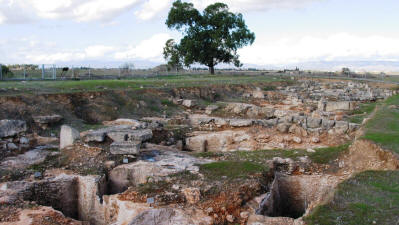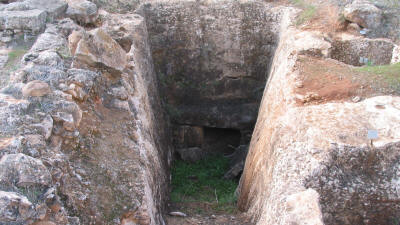Necropolis of Cellarka
Salamis, Near Famagusta, North Cyprus
 |
| The Cellarka Necropolis |
This necropolis is part of the Royal Tombs complex, but set about 400 yards away, closer to the village of Tuzla.
While the noble or rich citizens of Salamis were buried in the royal tombs, the common town people were buried here. The graves were first excavated in the 1890s, and finds included a finger ring in gold, on which in Egyptian hieroglyphics is an engraved dedication to the goddess Mut. In the same tomb, there were also found some massive gold pins of the type used by Greek women for fastening their garments on the shoulder.
Further finds in 1895 included two ivory carvings, about three inches square. One shows a lion attacking a bull. The other has a man slaying a gryphon. The gryphon, having the body of a lion with the wings and head of an eagle, is thrown onto its hind legs, and is about to receive a deadly thrust from the short sword of the man. The expression of fear in the animal, its tail between its leg, its great wings drooping, and its beak half open, is finely detailed.
 |
| An Entrance Dromos |
In the 1960s a further 114 were excavated on this site, although there is still much more work to be done. The tombs are entirely carved in the hard limestone, with one exception, that of the biggest and richest tomb of Cellarka, tomb 105, which is built of ashlar blocks.
The chambers are rectangular, and their dromos have staircases. Every tomb's dromos' surrounding is borderlined with smoothly-cut ashlar blocks.
As the hard rock was confined to a narrow strip of land, and as the necropolis was used for 400 years from the end of the 8th century BC, some tombs were built very close to others, some of them even overlapping. Some shaft tombs with chimney shaped entrances were built into some of the original tombs, but by the end of the 4th century BC, the necropolis could not cope with any more burials.
Finds here indicate that sacrifices and feast ceremonies took place in the dromos before the burials.
See the location in Google maps.
Return to Salamis Index or Famagusta Index.